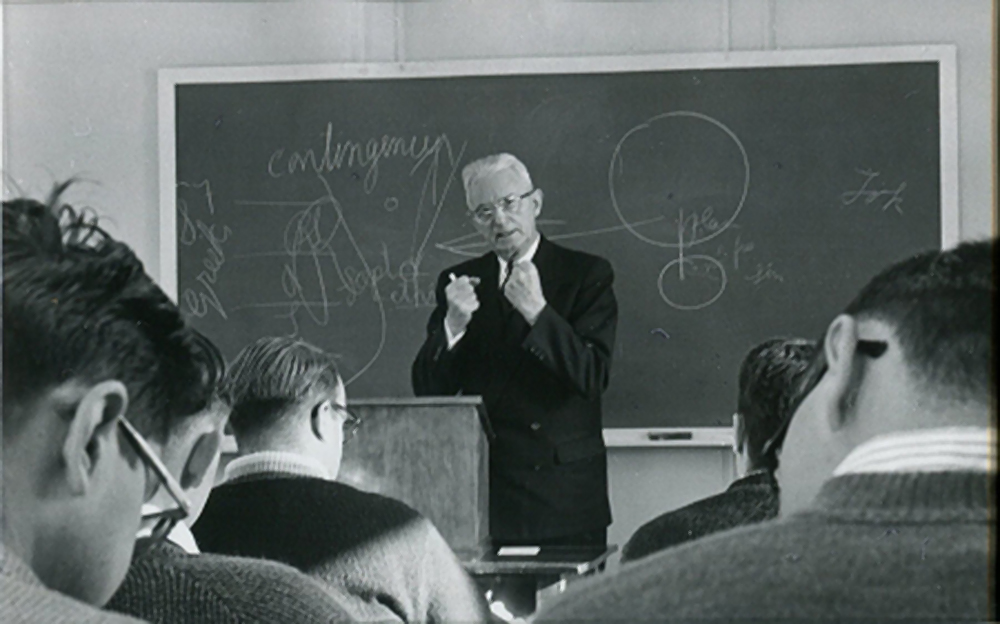 William Harry Jellema was a legendary philosophy professor at Calvin College. His students included Nicholas Wolterstorff, Alvin Plantinga, and William Frankena. He was also Cornelius Van Til’s teacher.
William Harry Jellema was a legendary philosophy professor at Calvin College. His students included Nicholas Wolterstorff, Alvin Plantinga, and William Frankena. He was also Cornelius Van Til’s teacher.
Van Til and Jellema came to represent two very different strands within the Dutch Calvinist community in the 20th century. Jellema is known to have told his students that he fully expected to meet Socrates in heaven—not the kind of verdict that sat well with Van Til’s strong emphasis on the antithesis between biblically grounded presuppositions and those based on non-Christian worldviews.
As someone who often found myself being pulled back and forth between the two perspectives—and as an admirer of both Van Til and Jellema—I was delighted by a story that John R. Muether told in his fine biography of Van Til. Toward the end of his life, Van Til returned to Grand Rapids and visited Jellema, who was close to death. On this occasion Van Til thanked his former teacher for what he had learned from him. Jellema responded: “Yes, but Kees, it was you who at times kept us from going too far.”
While I never went as far as Jellema in my own views on common grace, I certainly went further than Van Til would have liked. But I might have gone even further if it was not for Van Til’s influence on my thinking. His 95 page book, Common Grace, was the first serious theological work that I read, as third year college student, and I went on to read extensively in Van Til’s writings.
In one of my first philosophy courses I wrote an major paper on the disagreement on “common ground” between Van Til and his former student Edward John Carnell. My professor was Ronald Nash, who was a Carnellian on the subject, and I defended Van Til’s perspective. By the time I started doctoral studies in philosophy, however, I had moved significantly in Carnell’s direction. But I continued to read Van Til—I still do—and I can endorse Jellema’s tribute to him: while Van Til would not be happy with my views on commonness, I am grateful for the ways in which he kept me “from going too far.”
Recently I re-read a little pamphlet, Why I Believe in God, that Van Til wrote to explain his approach to apologetics in terms accessible to folks who might not be familiar with the details of his own system. In that short piece Van Til engages in a bit of fiction, imagining himself addressing a non-Christian intellectual in a relaxed conversation. In explaining why the idea of epistemic “neutrality” is not feasible, Van Til penned this marvelous passage, in which he insists that
What Van Til is saying here is in fact an endorsement of the idea of common ground. The believer and the unbeliever, when they engage each other’s worldviews, are in fact doing so as fellow occupants on God’s real estate, on which are posted many clear signs of divine ownership.
This is not to say that Van Til’s arguments with Carnell were not real disagreements. But the issue is not “ontology”: in reality, Van Til was insisting, both believers and non-believers stand on ground that is created by the very God about whose existence they are arguing. What Van Til refused to accept in Carnell’s approach was Carnell’s “noetic” application of that ontology: Carnell considered it legitimate to get the unbeliever to acknowledge what some of the real estate ownership signs point to: a shared moral sense, transcendent norms for cognitive assent to the truth of something, and the like.
But the real estate issue underlying the positions of both Van Til and Carnell is extremely important. What Van Til says to his fictional unbeliever about the God-owned real estate provided, for Carnell, a basis for engaging in a positive engagement with the unbeliever. Carnell wanted to keep discussing the real estate signs at the very point where Van Til was signaling that any further conversation, unless the Holy Spirit changes the heart-direction of his conversation partner, is fruitless.
The very fact, however, that Van Til makes his point about real estate in an imagined conversation with an unbeliever is a confirmation that he is not against all serious—and even friendly—conversation with those whose hearts have not been transformed by sovereign grace. Our conversations take place on a kind of common ground where we are surrounded by God’s real estate signs. It was precisely that awareness that motivated the Apostle Paul to tell the pagan worshipers on Mars Hill that “it is in Him”—the living God who has revealed Himself in Jesus Christ—“that we live and move and have our being.”
We live these days in a pagan context much like what Paul encountered in Athens. In engaging the cultural and philosophical issues in our own contemporary setting, it is good to hear Van Til encouraging us to point to the real estate signs. And while some of us may rightly see this as the first stage of an engagement with unbelievers that can keep going, it is also good to heed Van Til’s warnings about “going too far.”
Guest post by Dr. Richard Mouw, President Emeritus & Professor of Faith and Public Life at Fuller Theological Seminary
















